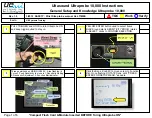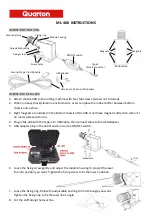
Tel: 886.2.2175 2930 Email: [email protected]
www.salukitec.com
228
It is important to understand the amplitude and phase information of the tested device to integrate high-level devices. Similar to the
amplitude measurement, the S-parameter is also applied in phase measurement. Phase measurement is a kind of relative (ratio)
measurement instead of absolute measurement. The phase of the signal into the device (incident signal) and the response signal are
compared in phase measurement. The response signal may be reflected signal or transmitted signal. Given that the analyzer is
accurately calibrated, the phase difference (i.e. phase shift) of two signals is the measurement result of phase characteristics of the
tested device. The following figure shows the phase offset between the incident signal and transmitted signal observed through the
oscilloscope.
Fig. 8.7 Phase Shift between Signals
8.2.2.
Why to perform phase measurement?
Phase measurement is an important function of the vector network analyzer. Fig. 8.8 shows the reasons for accurate measurement of
the amplitude and phase.
Fig. 8.8 Reasons for Accurate Amplitude and Phase Measurement
If the element and circuit are used to transmit signals in the communication system, signal distortion must be within the normal limits.
The signal distortion can be divided into two types.
1) Linear distortion: refer to the failure to keep the flat amplitude and linear phase shift within the relevant frequency range as a
result of frequency changes.
2) Nonlinear distortion: refer to the new spectrum component of the circuit, such as AM-PM transformation.
It is important to accurately measure the amplitude and phase characteristics of the element or circuit, so as to ensure the efficient
transmission or adsorption of energy in the circuit and prevent the distortion in signal transmission. A good example to prevent
distortion is to measure the complex impedance of the antenna.
8.2.3.
Use of Phase Format of Analyzer
The phase format of the analyzer is used to display the phase changes over the frequency or power. The phase difference beyond
±180° between the reference signal and response signal cannot be measured by the analyzer. If the phase value varies from +180° to
-180°, the sawtooth type phase measurement track will be displayed on the analyzer. The sawtooth waveform may not reach +180° or
-180° sometimes in measurement at the discrete frequency points. The data points of +180° and -180° may not be the points of
sweep measurement.
















































